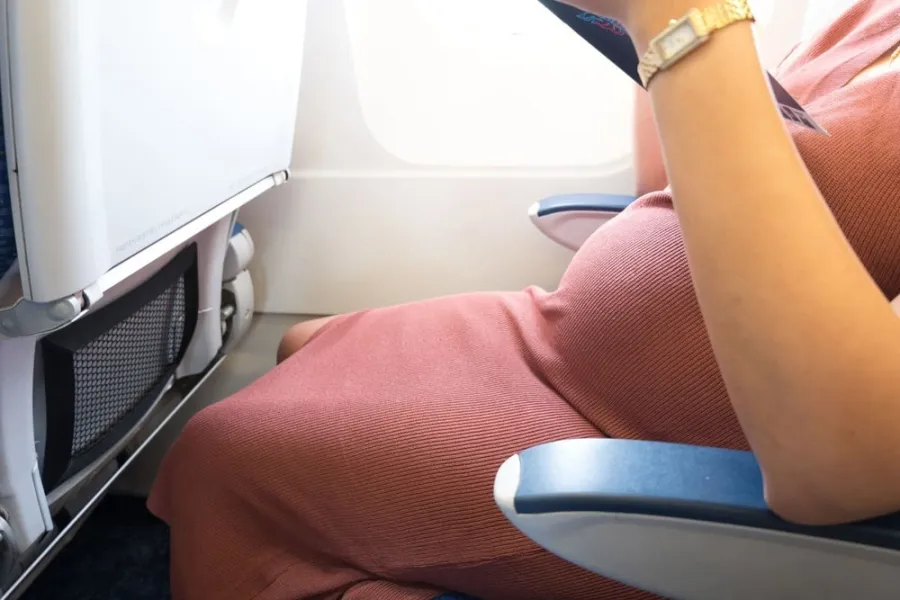Change language
Flying while pregnant: essential tips for safe and comfortable air travel
February 10, 2025

Traveling by air during pregnancy can be a smooth experience if you plan ahead and take the necessary precautions. Whether you're flying for leisure or necessity, these tips will help ensure your comfort and safety.
Check airline policies and medical recommendations!
Different airlines have distinct policies regarding travel while pregnant. The majority allow expectant mothers to fly up to the 36th week for single pregnancies and up to the 32nd week for multiple pregnancies.
However, certain airlines may require a medical certificate after the 28th week. It's therefore important that you check the specific airline’s policy prior to booking your flight. This can usually be found on the airline's official website or by contacting their customer service directly.
Importantly, before making any flight bookings, it's advised that you consult your healthcare provider. This is particularly essential if you have a high-risk pregnancy or any other health concerns. Your healthcare provider can offer personalized advice based on your specific health history and the details of your pregnancy. By doing so, you'll be ensuring not only your health but also the health of your unborn child. Remember to familiarize yourself with your rights regarding denied boarding due to pregnancy!
Timing your trip
The second trimester is often referred to as the ”golden period" of pregnancy for several reasons:
Morning sickness subsides:
By week 14, most women experience a significant reduction in nausea and vomiting. This makes it easier to handle the potential motion sickness and smells encountered during air travel.
Increased energy levels:
Hormonal changes stabilize, leading to improved energy and overall well-being. This is beneficial for managing the physical demands of travel, such as navigating airports and long flights.
Lower risk of complications:
The risks of miscarriage (higher in the first trimester) and premature labor (more likely in the third trimester) are lowest during the second trimester. This makes it a safer window for traveling.
Comfortable size:
By this stage, the baby bump is noticeable but not large enough to cause significant discomfort. Walking, sitting, and maneuvering through narrow airplane aisles is typically easier than in the later stages of pregnancy.
Fewer restrictions:
Most airlines do not require a medical certificate for travel during the second trimester, simplifying the booking and boarding process.
Avoid close to your due date: the risks of late pregnancy travel
Flying during the third trimester, especially after week 36, is generally discouraged for several reasons:
Increased risk of preterm labor:
The chances of going into labor increase as you approach your due date. Air travel could make it difficult to access medical care in case of an emergency.
Health risks for you and the baby:
- prolonged immobility increases the risk of deep vein thrombosis (DVT), which is already elevated during pregnancy;
- cabin pressure changes, although generally safe, might cause mild discomfort or exacerbate existing pregnancy-related issues.
Choose comfortable seating!
One of the most advised seating options for pregnant women is the aisle seat. An aisle seat provides you with this convenience, eliminating the need to disrupt your fellow passengers. Additionally, aisle seats provide more room for leg stretching, which can help reduce discomfort and swelling during the flight.
Moreover, seating with extra legroom can significantly enhance your comfort, particularly during long-haul flights. This extra space allows for more comfortable movement, stretching, and changing positions, which are essential in alleviating discomfort and reducing the risk of blood clots.
While it may involve an additional cost, upgrading your seat can be a worthwhile investment. As your pregnancy progresses, standard airplane seating may become more restrictive and uncomfortable.
To sum up, here are a few tips for choosing comfortable seating:
- Opt for an aisle seat for easy access to the restroom and more space for leg stretching.
- Consider seats with extra legroom, especially for long-haul flights.
- Think about upgrading your seat for additional comfort.
- Remember to move and stretch frequently, regardless of your seating choice.
Are you afraid of flying? Read how to overcome the fear of flying? 8 methods!
Stay hydrated and nourished!
Air travel can lead to dehydration due to the low humidity levels in airplane cabins. This can make pregnancy symptoms like nausea and fatigue worse. Therefore, it's crucial for you to drink plenty of water before, during, and after the flight.
- Hydrate frequently by carrying a refillable water bottle and sipping regularly.
- Bring your own low-sodium, nutritious snacks such as fruits, nuts, or granola bars.
- Monitor your sodium intake to prevent possible health risks.
- Eat small meals at regular intervals to maintain energy levels and prevent nausea.
Promote circulation!
Air travel involves long periods of sitting, which can restrict blood flow and increase the risk of swelling or deep vein thrombosis (DVT). Here’s how to stay active and maintain healthy circulation during your flight:
- Aim to stand up and walk up and down the aisle at least once an hour. This simple action helps stimulate blood flow, reduce swelling in your legs, and decrease the likelihood of developing blood clots. If walking isn’t possible, try standing near your seat and performing light stretches.
- Compression stockings provide gentle pressure to your legs, improving blood flow by preventing blood from pooling in the lower extremities. They are particularly useful for pregnant women, who are already at an increased risk of circulatory issues. Be sure to choose a pair that fits properly and is designed for travel or pregnancy use.
Do leg exercises while seated!
You can keep your blood circulating even while sitting by performing simple exercises:
- Ankle Rotations: lift your feet slightly off the floor and rotate your ankles in circles, alternating directions.
- Heel-to-Toe Lifts: alternate between lifting your heels off the floor while keeping your toes grounded, and lifting your toes while your heels stay on the floor.
- Knee Lifts: lift one leg slightly off the seat and hold for a few seconds before switching to the other leg.
These exercises can be done discreetly and effectively combat stiffness and swelling.
Dress for comfort!
Here are few tips to keep in mind:
- Choose clothes made of natural fibers like cotton or linen, as they are breathable and can help regulate body temperature.
- Opt for slip-on shoes for easy removal in case of feet swelling.
- Pack a light shawl or cardigan for layering.
- Remember to pack a portable charger (power bank) to keep your devices charged throughout the flight.
We hope that these tips will serve as a helpful guide for your journey. Safe travels and enjoy the adventure that awaits you and your baby!
More travel blog recommendations

Превърнете своя закъснял, отменен или резервиран полет в компенсация до €600!
Компенсацията за закъснение на полет е отменена
Възстановяване на сумата за отменен полет със закъснение
Компенсация за полет
©2025 AirClaim.com - Всички права запазени Air Claim SA - Bdul. Pipera 1/Vi Bl. HYPERION TOWERS Et. 3 SP. BIR. 3 Cod 077190, Voluntari, Ilfov, Румъния

















